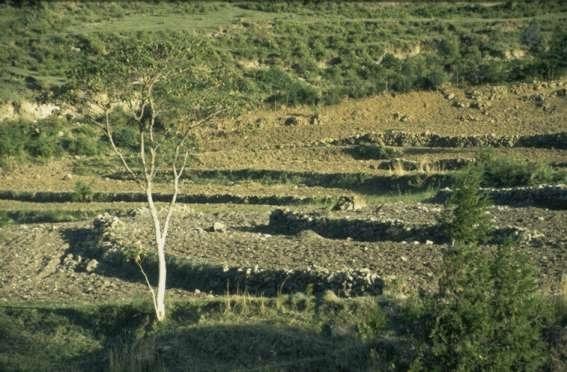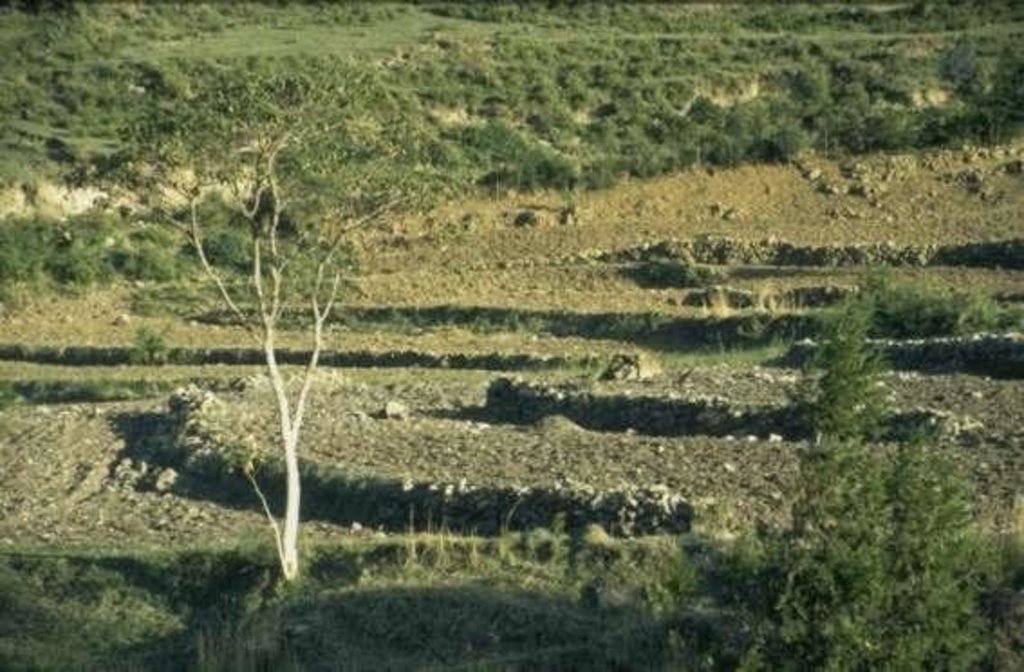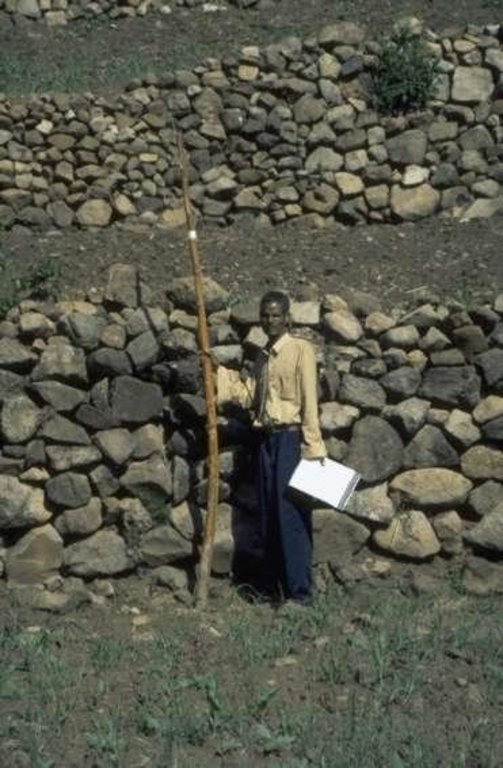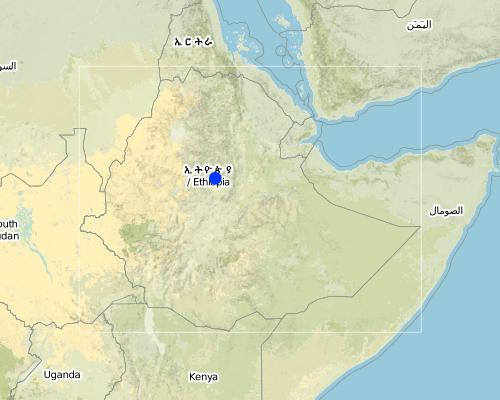stone bund [埃塞俄比亚]
- 创建:
- 更新:
- 编制者: Eva Ludi
- 编辑者: –
- 审查者: Fabian Ottiger
erkan (amharic), cab (amharic)
technologies_1389 - 埃塞俄比亚
查看章节
全部展开 全部收起1. 一般信息
1.2 参与该技术评估和文件编制的资源人员和机构的联系方式
有助于对技术进行记录/评估的机构名称(如相关)
Overseas Development Institute (ODI) - 英国1.3 关于使用通过WOCAT记录的数据的条件
(现场)数据是什么时候汇编的?:
26/04/1999
编制者和关键资源人员接受有关使用通过WOCAT记录数据的条件。:
是
2. SLM技术的说明
2.1 技术简介
技术定义:
stone terrace more or less along the contour, combined with artificial waterways and traditional ditches to drain excess water, and heightened field borders
2.2 技术的详细说明
说明:
stone bunds, height 0.5 m to 2.5 m, base width 1m to 1.5 m, top width 0.2 m to 1 m (top width mainly below 0.5 m). stones are piled very carefully to form stable terraces, masonry-like, stable drystone walls. In some cases, gesho (local hop, Rhamnus prinoides) is planted above the stone terrace. Bisana (Croton macrostachytus) is planted below the stone bund or along raised field borders. Stone bunds vary in height depending on the slope angle to reach, if possible, flat terraces behind the bund. Bunds are maintained regularly and if necessary bunds are raised. The technology is applied since generations in this area. Farmers continue to build bunds on new plots. A factor favouring the construction and maintenance of bunds - compared with many areas of the Ethiopian Highlans - is that the land distribution of 1996/97 was not carried out in Mesobit & Gedeba.
2.3 技术照片
2.5 已应用该技术的、本评估所涵盖的国家/地区/地点
国家:
埃塞俄比亚
区域/州/省:
North Shewa
Map
×2.6 实施日期
如果不知道确切的年份,请说明大概的日期:
- 50多年前(传统)
2.7 技术介绍
详细说明该技术是如何引入的:
- 作为传统系统的一部分(> 50 年)
注释(项目类型等):
No historical record
3. SLM技术的分类
3.2 应用该技术的当前土地利用类型

农田
- 一年一作
- 多年一作(非木材)
注释:
Major land use problems (compiler’s opinion): continuous cultivation and overgrazing due to high population pressure; declining soil fertility, which is only partially made up with increased inputs; pests
Major land use problems (land users’ perception): continuous cropping and overgrazing due to high population pressure, change of climate, pests
3.3 有关土地利用的更多信息
该技术所应用土地的供水:
- 雨养
注释:
Water supply: Also mixed rainfed - irrigated
每年的生长季节数:
- 2
具体说明:
Longest growing period from month to month: Apr - DecSecond longest growing period from month to month: Feb - May
3.4 该技术所属的SLM组
- 横坡措施
- 灌溉管理(包括供水、排水)
- 引水和排水
3.5 技术传播
具体说明该技术的分布:
- 均匀地分布在一个区域
如果该技术均匀地分布在一个区域上,请注明覆盖的大致区域。:
- 100-1,000 平方千米
注释:
Technology known since generations. Knowledge passed down from father to son. One person mentioned the year 1906 EC (1913 gregor. calendar) as the time when SWC started to be applied on a bigger scale in the area. Area of application: unknown. Information given below is for Mesobit and Gedeba KA only (ca 500 ha).
3.6 包含该技术的可持续土地管理措施

植物措施
- V1:乔木和灌木覆盖层
- V2:草和多年生草本植物

结构措施
- S2:堤、岸
- S3:分级沟渠、渠道、水道
注释:
Main measures: structural measures
Secondary measures: vegetative measures
3.7 该技术强调的主要土地退化类型

土壤水蚀
- Wt:表土流失/地表侵蚀
- Wg:冲沟侵蚀/沟蚀

化学性土壤退化
- Cn:肥力下降和有机质含量下降(非侵蚀所致)

水质恶化
- Ha:干旱化
注释:
Main type of degradation addressed: Wt: loss of topsoil / surface erosion
Secondary types of degradation addressed: Wg: gully erosion / gullying, Cn: fertility decline and reduced organic matter content, Ha: aridification
4. 技术规范、实施活动、投入和成本
4.2 技术规范/技术图纸说明
Technical knowledge required for land users: moderate
Main technical functions: control of dispersed runoff: impede / retard
Secondary technical functions: control of concentrated runoff: drain / divert, reduction of slope angle, increase of infiltration, increase / maintain water stored in soil, sediment retention / trapping, sediment harvesting, improvement of soil structure
Trees/ shrubs species: bisana (croton macrostachytus), accacia
Perennial crops species: gesho (rhamnus prinoides)
Slope (which determines the spacing indicated above): 15.00%
If the original slope has changed as a result of the Technology, the slope today is (see figure below): 5.00%
Construction material (earth): fills up trench behind bund to form level terrace, if soil is moved to build terrace, soil is distri
Construction material (stone): stone is main material , usually stones are collected in the field, sometimes solid rock is broken,
Slope (which determines the spacing indicated above): 15%
If the original slope has changed as a result of the Technology, the slope today is: 5%
Vegetation is used for stabilisation of structures.
Other type of management: livestock management - farmers pooling small area of grazing land
4.3 有关投入和成本计算的一般信息
其它/国家货币(具体说明):
Ethiopia Birr
注明美元与当地货币的汇率(如相关):1美元=:
7.0
4.4 技术建立活动
| 活动 | 措施类型 | 时间 | |
|---|---|---|---|
| 1. | planting | 植物性的 | beginning of and during rainy season |
| 2. | manuring | 植物性的 | beginning of and during rainy season |
| 3. | collecting stones | 结构性的 | May-June |
| 4. | piling stones | 结构性的 | May-June |
| 5. | observing slope | 结构性的 | |
| 6. | digging | 结构性的 | May-June, small 'dry' season between small and big |
4.5 技术建立所需要的费用和投入
注释:
Duration of establishment phase: 48 month(s)
4.6 维护/经常性活动
| 活动 | 措施类型 | 时间/频率 | |
|---|---|---|---|
| 1. | weeding | 植物性的 | /annual, several times |
| 2. | cutting branches (gesho) | 植物性的 | /every 2nd to 3rd year |
| 3. | piling stones | 结构性的 | February-June/annual |
| 4. | reparing broken terraces | 结构性的 | February-June/annual |
4.7 维护/经常性活动所需要的费用和投入(每年)
注释:
length of structure, per day one person constructs about 3 m new stone bund
4.8 影响成本的最重要因素
描述影响成本的最决定性因素:
financial costs are very small compared to manual labour. Costs for labour as indicated in 2.7.1. are given as opportunity costs!
much of the labour is done using traditional group work debo (= working party) or wenfel (= reciprocal work) or newly introduced group work (mass mobilisation).
5. 自然和人文环境
5.1 气候
年降雨量
- < 250毫米
- 251-500毫米
- 501-750毫米
- 751-1,000毫米
- 1,001-1,500毫米
- 1,501-2,000毫米
- 2,001-3,000毫米
- 3,001-4,000毫米
- > 4,000毫米
有关降雨的规范/注释:
Two growing seasons for teff
5.2 地形
平均坡度:
- 水平(0-2%)
- 缓降(3-5%)
- 平缓(6-10%)
- 滚坡(11-15%)
- 崎岖(16-30%)
- 陡峭(31-60%)
- 非常陡峭(>60%)
地形:
- 高原/平原
- 山脊
- 山坡
- 山地斜坡
- 麓坡
- 谷底
垂直分布带:
- 0-100 m a.s.l.
- 101-500 m a.s.l.
- 501-1,000 m a.s.l.
- 1,001-1,500 m a.s.l.
- 1,501-2,000 m a.s.l.
- 2,001-2,500 m a.s.l.
- 2,501-3,000 m a.s.l.
- 3,001-4,000 m a.s.l.
- > 4,000 m a.s.l.
5.3 土壤
平均土层深度:
- 非常浅(0-20厘米)
- 浅(21-50厘米)
- 中等深度(51-80厘米)
- 深(81-120厘米)
- 非常深(> 120厘米)
土壤质地(表土):
- 中粒(壤土、粉土)
- 细粒/重质(粘土)
表土有机质:
- 中(1-3%)
如有可能,附上完整的土壤描述或具体说明可用的信息,例如土壤类型、土壤酸碱度、阳离子交换能力、氮、盐度等。:
Soil depth on average: Moderately deep, also deep (soil depths estimated only. soil depth also varies depending on location in relation to stone bund.)
Soil fertility is medium
Soil infiltration/drainage is good
Soil water storage capacity is high
5.6 应用该技术的土地使用者的特征
非农收入:
- 低于全部收入的10%
相对财富水平:
- 贫瘠
- 平均水平
机械化水平:
- 手工作业
- 畜力牵引
说明土地使用者的其他有关特征:
Annual population growth: 2% - 3%
5% of the land users are rich (yield lasts for 12 months).
80% of the land users are average wealthy (yield lasts for 8 months).
15% of the land users are poor (yield lasts for less than 8 monts and people are involved in petty trade).
Off-farm income specification: Some families rely heavily on off-farm income (petty trade, handicraft). For these families, off-farm income can be as high as 50%, usually it is in the order of 10-20%.
5.8 土地所有权、土地使用权和水使用权
土地所有权:
- 州
土地使用权:
- 个人
6. 影响和结论性说明
6.4 成本效益分析
技术收益与技术建立成本相比如何(从土地使用者的角度看)?
短期回报:
中性/平衡
长期回报:
积极
技术收益与技术维护成本/经常性成本相比如何(从土地使用者的角度看)?
短期回报:
稍微积极
长期回报:
积极
6.5 技术采用
在所有采用这项技术的人当中,有多少人是自发地采用该技术,即未获得任何物质奖励/付款?:
- 90-100%
注释:
Comments on acceptance with external material support: estimates
Comments on spontaneous adoption: estimates
Comments on adoption trend: young farmers are a bit more reluctant to continue building new bunds, however they maintain existing bunds.
链接和模块
全部展开 全部收起链接
无链接
模块
无模块





